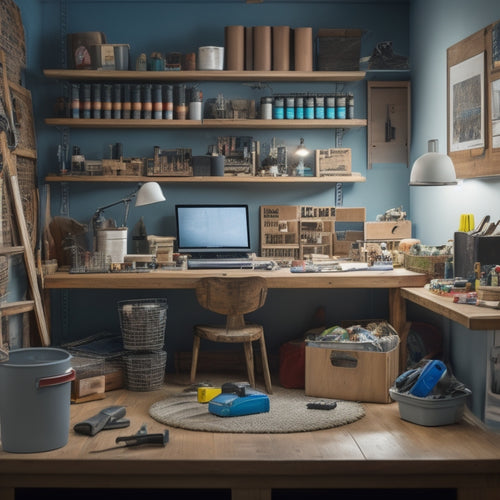
Discover the Art of Circuit Construction
Share
As I explore the world of electronics, I've discovered that circuit construction is an intricate dance of creativity and technical skill. Building circuits isn't just about connecting components - it's about bringing DIY creations to life. To master this art, I've learned to focus on understanding basic circuit components, practicing with simple circuits, and deciphering schematics. By constructing and testing my designs, I've refined my skills in troubleshooting and fine-tuning. With each project, I'm able to tap into my creative potential, and I'm excited to see where this journey takes me next - and what innovative circuits I'll bring to life.
Key Takeaways
• Mastering circuit construction requires understanding basic components, progressing from simple to complex circuits, and using online resources like Adafruit and SparkFun.
• Deciphering schematics and symbols is crucial, as they act as a roadmap for circuit construction and represent components and connections.
• Building and testing circuits brings designs to life, and troubleshooting techniques, simulation software, and careful component selection ensure circuit success.
• Effective circuit design involves identifying problems, brainstorming solutions, experimenting with creative projects, and refining designs through prototyping and advanced techniques.
• Hands-on learning with electronics kits and resources like Make magazine's Electronics PDF bundle sparks creativity and develops DIY circuit-building skills.
The Importance of Circuit Building
Building circuits from scratch is an essential aspect of model railroading. It allows me to enhance my skills and take pride in seeing my DIY creations come to life. For instance, when the lights on my miniature train station turn on. I've discovered that circuit creativity is crucial to bringing my model railroad to life.
With DIY circuits, I can troubleshoot and fine-tune my designs to achieve the desired effect. Electronics kits have been a game-changer for me. They provide a hands-on way to learn circuit building and spark my creativity. Websites like Build Your Own Clone and Adafruit offer interesting kits that challenge me to think outside the box.
Learning the Fundamentals of Circuits
Many engineering programs I've encountered lack practical circuit-building experience, which is why I've turned to DIY electronics kits and online resources to fill this gap. To learn the fundamentals of circuits, I've focused on understanding basic circuit components and diving into hands-on projects.
Here are some essential takeaways:
- Start with simple circuits and gradually move to complex ones
- Familiarize yourself with basic components like resistors, capacitors, and transistors
- Online resources like Adafruit and SparkFun offer guides and tutorials for beginners
- Electronics kits provide a practical way to learn circuit building
- Make magazine's Electronics PDF bundle is a valuable resource for DIY projects
Deciphering Schematics and Symbols
As I've begun to grasp the fundamentals of circuits, I've realized that understanding schematics is the next essential step in my circuit-building journey. Schematics are like a roadmap, guiding me through the twists and turns of circuit construction.
To decipher them, I need to crack the code of symbols and connections. Reading symbols is key - each component has its own unique symbol, and I've got to know what they mean. Understanding connections is just as vital; those squiggly lines represent the flow of electricity between parts.
With practice, I'm getting better at recognizing resistors, capacitors, and diodes. Now, I can start building circuits with confidence, knowing that I can read the blueprint and bring my creations to life.
Building and Testing Circuits
With my newfound understanding of schematics, I'm now ready to put my knowledge into practice by constructing and testing circuits that bring my designs to life.
Building and testing circuits is where the magic happens, and I'm excited to see my creations come alive. To guarantee success, I'll be using circuit troubleshooting techniques to identify and fix any issues that arise. I'll also be utilizing advanced circuit simulation software to model and test my designs before building them.
Here are some key considerations for building and testing circuits:
- Choose the right components for the job
- Use a solderless breadboard to test and refine your design
- Keep your workspace organized and tidy
- Don't be afraid to ask for help when you're stuck
- Be patient and persistent – circuit building can be frustrating at times!
Designing and Refining Circuits
I approach circuit design by first identifying the problem I'm trying to solve, then brainstorming a list of requirements and constraints that my circuit must meet. This helps me to narrow down the possibilities and create a clear plan of attack.
From there, I delve into circuit optimization, using advanced circuit techniques to refine my design. I love experimenting with creative circuit projects, and circuit prototyping is an essential step in bringing my ideas to life.
Frequently Asked Questions
Can I Use Any Type of Wire for Circuit Construction?
When it comes to circuit construction, wire selection is essential. Not just any wire will do. I need wires with the right gauge, material, and insulation to guarantee my circuit functions safely and efficiently. I've got to take into account the insulation type, too. Using the wrong wire can lead to shorts, fires, or worse - a circuit that just doesn't work!
Ensuring I select the appropriate wire for my circuit is crucial for its proper functioning and safety. It's important to consider factors such as gauge, material, and insulation type when choosing wires. The wrong wire choice can result in various issues, including shorts, fires, or circuit failure.
How Do I Troubleshoot a Circuit That's Not Working?
'Back in the day, I'd troubleshoot a circuit by throwing darts at a wiring diagram - okay, not really, but it felt like that sometimes!
When a circuit isn't working, I start with circuit analysis to identify the issue.
Next, I whip out my trusty multimeter for voltage measurement to check for any wonky voltages.
What Safety Precautions Should I Take When Building Circuits?
When building circuits, I prioritize safety precautions.
I avoid electrical shock by keeping my work area dry, using insulated tools, and never touching components with my bare hands.
I mitigate fire hazards by using a fire-resistant work surface, keeping flammable materials away, and not overheating components.
I also unplug my project when not in use and guarantee proper ventilation.
Safety first, circuit success later!
Can I Build Circuits With Second-Hand or Salvaged Components?
When scouring for second-hand components, I'm always on the lookout for gems hidden among the junk. Refurbishment techniques are key to breathing new life into salvaged parts.
I inspect each component carefully, cleaning and testing before reuse. Component sourcing from online forums, thrift stores, and surplus shops can be a treasure hunt.
With patience and the right skills, I can build functional circuits from discarded treasures, giving old components a new lease on life.
How Do I Store and Organize My Circuit Building Supplies?
Storing and organizing my circuit building supplies is a challenge I'm all too familiar with. I've learned to label everything meticulously, from resistors to capacitors, using a labeling system that makes sense to me.
Storage bins are my new best friends - they keep my workspace tidy and prevent those tiny components from getting lost in the chaos.
With everything in its place, I can focus on building circuits, not searching for that one pesky transistor.
Related Posts
-

Master Home Organization With These 5 Online Courses
You're about to gain control over your living space with an all-inclusive education in home organization, courtesy of...
-

What Makes Effective Online DIY Home Organization Courses?
You're about to reveal the secrets to transforming your living space into a serene and functional oasis, and it all b...

